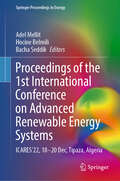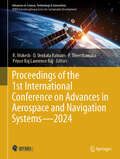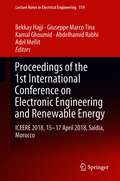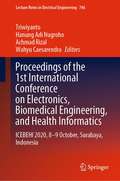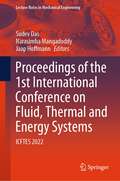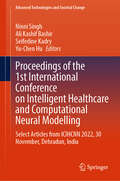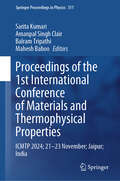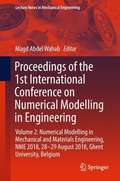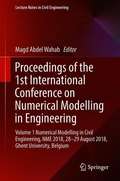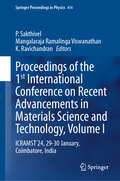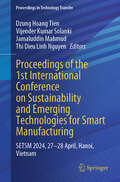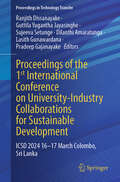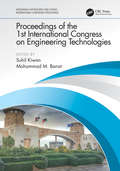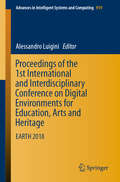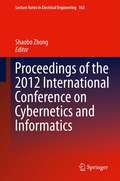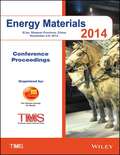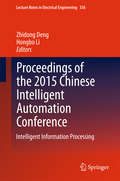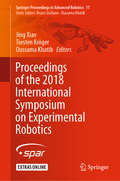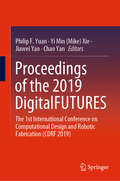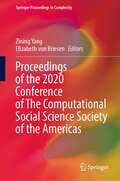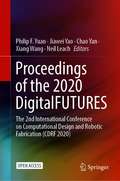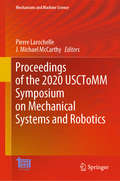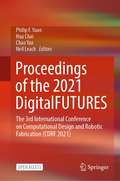- Table View
- List View
Proceedings of the 1st International Conference on Advanced Renewable Energy Systems: ICARES’22, 18–20 Dec, Tipaza, Algeria (Springer Proceedings in Energy)
by Adel Mellit Hocine Belmili Bacha SeddikThis book presents peer-reviewed articles from the First International Conference on Advanced Renewable Energy Systems (ICARES’22) held in Tipaza, Algeria. It includes recent advances and issues related to the field of renewable energy systems. It focuses on the advances in renewable energy systems, its applications, and new concepts. It brings together researchers, engineers, manufacturers, and students from all over the world to share and discuss recent advancements and developments in renewable energy research and applications.
Proceedings of the 1st International Conference on Advances in Aerospace and Navigation Systems - 2024 (Advances in Science, Technology & Innovation)
by R. Mukesh D. Venkata Ratnam P. Theerthamalai Prince Raj Lawrence RajThis book contributes to the advancement of aerospace technology and the optimization of navigation systems, thereby fostering innovation and progress in the field. The "Proceedings of the 1st International Conference on Advances in Aerospace and Navigation Systems 2024" captures a comprehensive exploration of groundbreaking research and advancements in the fields of Aerospace and Navigation. Encompassing Aerodynamics, Propulsion, Structures, Navigation, Communication, and Artificial Intelligence, these proceedings investigate the details of each domain, providing readers with a thorough understanding of the latest developments and methodologies. One of the distinguishing features of this book is its international perspective. With contributions from esteemed experts hailing from different corners of the globe, these proceedings foster a global dialogue, facilitating cross-cultural insights and collaboration. Through planetary talks and keynote addresses, readers gain access to the wisdom and expertise of renowned speakers, enhancing their comprehension of critical topics shaping the future of aerospace and navigation systems. The conference proceedings offer a platform for in-depth exploration and analysis, addressing many of the themes such as aerodynamic design, propulsion systems, structures, navigation techniques, communication systems, and the integration of artificial intelligence in aerospace applications. Furthermore, these proceedings serve as a repository of state-of-the-art research, providing readers with access to cutting-edge studies and innovative approaches. This book offers a wealth of knowledge and insights for scholars, practitioners, and students alike. In addition to its academic significance, these proceedings hold practical relevance for industry professionals and policymakers. In summary, the "Proceedings of the 1st International Conference on Advances in Aerospace and Navigation Systems 2024" stands as a testament to the collective efforts of the global aerospace community. With its comprehensive coverage, international perspective, and commitment to excellence, this book promises to be an invaluable resource for anyone invested in the future of aerospace and navigation technology.
Proceedings of the 1st International Conference on Electronic Engineering and Renewable Energy: ICEERE 2018, 15-17 April 2018, Saidia, Morocco (Lecture Notes in Electrical Engineering #519)
by Bekkay Hajji Giuseppe Marco Tina Kamal Ghoumid Abdelhamid Rabhi Adel MellitThe proceedings present a selection of refereed papers presented at the 1st International Conference on Electronic Engineering and Renewable Energy (ICEERE 2018) held during 15-17 April 2018, Saidi, Morocco.The contributions from electrical engineers and experts highlight key issues and developments essential to the multifaceted field of electrical engineering systems and seek to address multidisciplinary challenges in Information and Communication Technologies. The book has a special focus on energy challenges for developing the Euro-Mediterranean regions through new renewable energy technologies in the agricultural and rural areas.The book is intended for academia, including graduate students, experienced researchers and industrial practitioners working in the fields of Electronic Engineering and Renewable Energy.
Proceedings of the 1st International Conference on Electronics, Biomedical Engineering, and Health Informatics: ICEBEHI 2020, 8-9 October, Surabaya, Indonesia (Lecture Notes in Electrical Engineering #746)
by Triwiyanto Hanung Adi Nugroho Achmad Rizal Wahyu CaesarendraThis Conference proceeding presents high-quality peer-reviewed papers from the International Conference on Electronics, Biomedical Engineering, and Health Informatics (ICEBEHI) 2020 held at Surabaya, Indonesia. The contents are broadly divided into three parts: (i) Electronics, (ii) Biomedical Engineering, and (iii) Health Informatics. The major focus is on emerging technologies and their applications in the domain of biomedical engineering. It includes papers based on original theoretical, practical, and experimental simulations, development, applications, measurements, and testing. Featuring the latest advances in the field of biomedical engineering applications, this book serves as a definitive reference resource for researchers, professors, and practitioners interested in exploring advanced techniques in the field of electronics, biomedical engineering, and health informatics. The applications and solutions discussed here provide excellent reference material for future product development.
Proceedings of the 1st International Conference on Fluid, Thermal and Energy Systems: ICFTES 2022 (Lecture Notes in Mechanical Engineering)
by Sudev Das Narasimha Mangadoddy Jaap HoffmannThis book comprises the proceedings of the 1st International Conference on Fluid, Thermal and Energy Systems. The contents of this book focus on phase change heat transfer, advanced energy systems, separated flows, turbulence and multi-phase modeling, computational fluid flow and heat transfer, thermal energy storage systems, integrated energy systems, nuclear thermal hydraulics, heat transfer in nanofluids, etc. This book serves as a useful reference to researchers, academicians, and students interested in the broad field of thermo-fluid science and engineering.
Proceedings of the 1st International Conference on Intelligent Healthcare and Computational Neural Modelling: Select Articles from ICIHCNN 2022, 30 November, Dehradun, India (Advanced Technologies and Societal Change)
by Yu-Chen Hu Seifedine Kadry Ali Kashif Bashir Ninni SinghThis book includes peer-reviewed articles from the 1st International Conference on Intelligent Healthcare and Computational Neural Modelling (ICIHCNN—2022), held on November 30, 2022, at Dehradun, India. It covers the latest research trends and developments in areas of Data Science, Artificial Intelligence, Neural Networks, Cognitive Neuroscience and Machine Learning Applications, Cyber-Physical Systems, and Cybernetics.
Proceedings of the 1st International Conference on Materials and Thermophysical Properties: ICMTP-2024, 21-23 November, Jaipur, India (Springer Proceedings in Physics #311)
by Sarita Kumari Amanpal Singh Balram Tripathi Mahesh BabooThis book highlights the latest research advancements and developments in the fields of materials science and thermophysical properties. It includes peer reviewed articles from the 1st International Conference on Materials and Thermophysical Properties (ICMTP-2024), held at the University of Rajasthan, Jaipur, India, from November 21 to 23. The proceedings cover a wide range of topics, including polymeric materials, multifunctional materials, materials for energy and biological applications, glass and ceramic materials, and thermophysical properties. With contributions from leading scientists, researchers, and industry professionals, this book serves as a valuable resource for academicians and practitioners alike, fostering knowledge exchange and collaboration in these critical areas of research. The topics and subtopics of the edited book may be arranged in the following manner: Section I: Polymeric Materials. Section II: Multifunctional Materials. Section III: Materials for Biological Applications. Section IV: Materials for Energy Applications. Section V: Glass and Ceramic Materials. Section VI: Materials for Nuclear Applications.
Proceedings of the 1st International Conference on Numerical Modelling in Engineering: Volume 1 Numerical Modelling In Civil Engineering, Nme 2018, 28-29 August 2018, Ghent University, Belgium (Lecture Notes in Civil Engineering #20)
by Magd Abdel WahabThis book gathers outstanding papers on numerical modeling in Mechanical Engineering (Volume 2) as part of the proceedings of the 1st International Conference on Numerical Modeling in Engineering (NME 2018), which was held in Ghent, Belgium. The overall objective of the conference was to bring together international scientists and engineers in academia and industry from fields related to advanced numerical techniques, such as the finite element method (FEM), boundary element method (BEM), isogeometric analysis (IGA), etc., and their applications to a wide range of engineering disciplines. This book addresses various industrial engineering applications of numerical simulations to Mechanical and Materials Engineering, including: Aerospace applications, Acoustic analysis, Biomechanical applications, Contact problems and wear, Heat transfer analysis, Vibration and dynamics, Transient analysis, Nonlinear analysis, Composite materials, Polymers, Metal alloys, Fracture mechanics, Fatigue of materials, Creep behavior, Phase transformation, and Crystal plasticity.
Proceedings of the 1st International Conference on Numerical Modelling in Engineering: Volume 1 Numerical Modelling in Civil Engineering, NME 2018, 28-29 August 2018, Ghent University, Belgium (Lecture Notes in Civil Engineering #20)
by Magd Abdel WahabThis book contains manuscripts of topics related to numerical modeling in Civil Engineering (Volume 1) as part of the proceedings of the 1st International Conference on Numerical Modeling in Engineering (NME 2018), which was held in the city of Ghent, Belgium. The overall objective of the conference is to bring together international scientists and engineers in academia and industry in fields related to advanced numerical techniques, such as FEM, BEM, IGA, etc., and their applications to a wide range of engineering disciplines. This volume covers industrial engineering applications of numerical simulations to Civil Engineering, including: Bridges and dams, Cyclic loading, Fluid dynamics, Structural mechanics, Geotechnical engineering, Thermal analysis, Reinforced concrete structures, Steel structures, Composite structures.
Proceedings of the 1st International Conference on Recent Advancements in Materials Science and Technology, Volume I: ICRAMST'24, 29-30 January, Coimbatore, India (Springer Proceedings in Physics #414)
by P. Sakthivel Mangalaraja Ramalinga Viswanathan K. RavichandranThis book presents peer-reviewed and selected papers from the 1st International Conference on Recent Advancements in Materials Science and Technology held at Karpagam Academy of Higher Education in Coimbatore, India, on 29-30 January 2024. Experts across the world share the latest developments in their respective fields within materials science, including nanomaterials, biomaterials, optical materials, construction materials, composite materials and more. Additionally, addressing sustainability and the importance of international collaboration, this book serves as an up-to-date and effective resource for researchers, academics, industrialists, and students looking to understand the state of numerous materials science subfields.
Proceedings of the 1st International Conference on Recent Advancements in Materials Science and Technology, Volume II: ICRAMST'24, 29-30 January, Coimbatore, India (Springer Proceedings in Physics #415)
by P. Sakthivel Mangalaraja Ramalinga Viswanathan K. RavichandranThis book presents peer-reviewed and selected papers from the 1st International Conference on Recent Advancements in Materials Science and Technology held at Karpagam Academy of Higher Education in Coimbatore, India, on 29-30 January 2024. Experts across the world share the latest developments in their respective fields within materials science, including nanomaterials, biomaterials, optical materials, construction materials, composite materials and more. Additionally, addressing sustainability and the importance of international collaboration, this book serves as an up-to-date and effective resource for researchers, academics, industrialists, and students looking to understand the state of numerous materials science subfields.
Proceedings of the 1st International Conference on Sustainability and Emerging Technologies for Smart Manufacturing: SETSM 2024, 27–28 April, Hanoi, Vietnam (Proceedings in Technology Transfer)
by Vijender Kumar Solanki Thi Dieu Linh Nguyen Dzung Hoang Tien Jamaluddin MahmudThis book presents peer-reviewed articles from the 1st International Conference on Sustainability and Emerging Technologies for Smart Manufacturing (SETSM 2024) held on 27–28 April at Hanoi in Vietnam. It includes the latest research and innovations in Sustainability and emerging technologies for Smart Manufacturing and Industry 4.0, especially innovative solutions for development of sustainable and smart eco-systems for a wide range of applications in industries, health care, and medicine.
Proceedings of the 1st International Conference on University-Industry Collaborations for Sustainable Development: ICSD 2024 16–17 March Colombo, Sri Lanka (Proceedings in Technology Transfer)
by Dilanthi Amaratunga Ranjith Dissanayake Guttila Yugantha Jayasinghe Pradeep Gajanayake Sujeeva Setunge Lasith GunawardanaThis book includes peer reviewed articles from the 1st International Conference on University-industry Collaborations for Sustainable Development (ICSD 2024) under the themes of Student Employability, Blended Learning, Invention and Innovation, Technoentrepreneurial Skills, Curriculum Development, Multidisciplinary Joint Research, and other initiatives., etc. It highlights the latest knowledge of strategic university-industry partnerships in Asian universities and brings together academic and industry experts to exchange knowledge and foster collaboration.
Proceedings of the 1st International Congress on Engineering Technologies: EngiTek 2020, 16-18 June 2020, Irbid, Jordan (Mosharaka for Research and Studies International Conference Proceedings (P-MIC))
by Suhil KiwanThis first volume in the Mosharaka for Research and Studies International Conference Proceedings series (P-MIC) contains peer-reviewed papers presented at the 1st International Congress on Engineering Technologies (EngiTek 2020). This event was held remotely on 16-18 June 2020, and hosted by the Faculty of Engineering, Jordan University of Science & Technology (Irbid, Jordan). The conference represented a major forum for professors, students, and professionals from all over the world to present their latest research results, and to exchange new ideas and practical experiences in the most cutting-edge areas of the field of engineering technologies. Topics covered include electrical engineering, computer science and electronics.
Proceedings of the 1st International and Interdisciplinary Conference on Digital Environments for Education, Arts and Heritage: EARTH 2018 (Advances in Intelligent Systems and Computing #919)
by Alessandro LuiginiThis book gathers peer-reviewed papers presented at the 1st International and Interdisciplinary Conference on Digital Environments for Education, Arts and Heritage (EARTH2018), held in Brixen, Italy in July 2018. The papers focus on interdisciplinary and multi-disciplinary research concerning cutting-edge cultural heritage informatics and engineering; the use of technology for the representation, preservation and communication of cultural heritage knowledge; as well as heritage education in digital environments; innovative experiments in the field of digital representation; and methodological reflections on the use of IT tools in various educational contexts. The scope of the papers ranges from theoretical research to applications, including education, in several fields of science, technology and art. EARTH 2018 addressed a variety of topics and subtopics, including digital representation technologies, virtual museums and virtual exhibitions, virtual and augmented reality, digital heritage and digital arts, art and heritage education, teaching and technologies for museums, VR and AR technologies in schools, education through digital media, psychology of perception and attention, psychology of arts and communication, as well as serious games and gamification. As such the book provides architects, engineers, computer scientists, social scientists and designers interested in computer applications and cultural heritage with an overview of the latest advances in the field, particularly in the context of science, arts and education.
Proceedings of the 2012 International Conference on Cybernetics and Informatics
by Shaobo ZhongProceedings of the International Conference on Cybernetics and Informatics (ICCI 2012) covers the hybridization in control, computer, information, communications and applications. ICCI 2012 held on September 21-23, 2012, in Chongqing, China, is organized by Chongqing Normal University, Chongqing University, Nanyang Technological University, Shanghai Jiao Tong University, Hunan Institute of Engineering, Beijing University, and sponsored by National Natural Science Foundation of China (NSFC). This two volume publication includes selected papers from the ICCI 2012. Covering the latest research advances in the area of computer, informatics, cybernetics and applications, which mainly includes the computer, information, control, communications technologies and applications.
Proceedings of the 2014 Energy Materials Conference: Xi'an, Shaanxi Province, China, November 4 - 6, 2014
by The Minerals, Metals & Materials SocietyThis DVD contains a collection of papers presented at Energy Materials 2014, a conference organized jointly by The Chinese Society for Metals (CSM) and The Minerals, Metals & Materials Society (TMS), and held November 4-6, 2014, in Xi’an, Shaanxi Province, China. With the rapid growth of the world’s energy production and consumption, the important role of energy materials has achieved worldwide acknowledgement. Material producers and consumers constantly seek the possibility of increasing strength, improving fabrication and service performance, simplifying processes, and reducing costs. Energy Materials 2014 has provided a forum for academics, researchers, and engineers around the world to exchange state-of-the-art development and information on issues related to energy materials. The papers on the DVD are organized around the following topics: Materials for Coal-Based Systems Materials for Gas Turbine Systems Materials for Nuclear Systems Materials for Oil and Gas Materials for Pressure Vessels
Proceedings of the 2015 Chinese Intelligent Automation Conference
by Hongbo Li Zhidong DengProceedings of the 2015 Chinese Intelligent Automation Conference presents selected research papers from the CIAC'15, held in Fuzhou, China. The topics include adaptive control, fuzzy control, neural network based control, knowledge based control, hybrid intelligent control, learning control, evolutionary mechanism based control, multi-sensor integration, failure diagnosis, reconfigurable control, etc. Engineers and researchers from academia, industry and the government can gain valuable insights into interdisciplinary solutions in the field of intelligent automation.
Proceedings of the 2015 International Conference on Communications, Signal Processing, and Systems
by Qilian Liang Wei Wang Jiasong Mu Baoju ZhangThis book brings together papers presented at the 4th International Conference on Communications, Signal Processing, and Systems, which provides a venue to disseminate the latest developments and to discuss the interactions and links between these multidisciplinary fields. Spanning topics ranging from Communications, Signal Processing and Systems, this book is aimed at undergraduate and graduate students in Electrical Engineering, Computer Science and Mathematics, researchers and engineers from academia and industry as well as government employees (such as NSF, DOD, DOE, etc).
Proceedings of the 2018 International Symposium on Experimental Robotics (Springer Proceedings in Advanced Robotics #11)
by Jing Xiao Oussama Khatib Torsten KrögerIn addition to the contributions presented at the 2018 International Symposium on Experimental Robotics (ISER 2018), this book features summaries of the discussions that were held during the event in Buenos Aires, Argentina. These summaries, authored by leading researchers and session organizers, offer important insights on the issues that drove the symposium debates. Readers will find cutting-edge experimental research results from a range of robotics domains, such as medical robotics, unmanned aerial vehicles, mobile robot navigation, mapping and localization, field robotics, robot learning, robotic manipulation, human–robot interaction, and design and prototyping. In this unique collection of the latest experimental robotics work, the common thread is the experimental testing and validation of new ideas and methodologies. The International Symposium on Experimental Robotics is a series of bi-annual symposia sponsored by the International Foundation of Robotics Research, whose goal is to provide a dedicated forum for experimental robotics research. In recent years, robotics has broadened its scientific scope, deepened its methodologies and expanded its applications. However, the significance of experiments remains at the heart of the discipline. The ISER gatherings are an essential venue where scientists can meet and have in-depth discussions on robotics based on this central tenet.
Proceedings of the 2019 DigitalFUTURES: The 1st International Conference on Computational Design and Robotic Fabrication (CDRF 2019)
by Philip F. Yuan Yi Min Mike Xie Jiawei Yao Chao YanThe “2019 DigitalFUTURES — The 1st International Conference on Computational Design and Robotic Fabrication (CDRF 2019)” provides an international platform for advanced scientific research papers on the digital technology of architectural design and construction. The themes of the papers include, but are not limited to, architectural theories, tools, methods and procedures in material intelligence, data intelligence; computational intelligence, and robotic intelligence.
Proceedings of the 2020 Conference of The Computational Social Science Society of the Americas (Springer Proceedings in Complexity)
by Zining Yang Elizabeth Von BriesenThis book is comprised of the latest research into CSS methods, uses, and results, as presented at the 2020 annual conference of the Computational Social Science Society of the Americas (CSSSA). Computational social science (CSS) is the science that investigates social and behavioral dynamics through social simulation, social network analysis, and social media analysis. The CSSSA is a professional society that aims to advance the field of computational social science in all areas, including basic and applied orientations, by holding conferences and workshops, promoting standards of scientific excellence in research and teaching, and publishing research findings and results. The above-mentioned conference was held virtually, October 8 – 11, 2020. What follows is a diverse representation of new results and approaches to using the tools of CSS and agent-based modeling (ABM) in exploring complex phenomena across many different domains. Readers will therefore not only have the results of these specific projects upon which to build, along with a wealth of case-study examples that can serve as meaningful exemplars for new research projects and activities, they will also gain a greater appreciation for the broad scope of CSS.
Proceedings of the 2020 DigitalFUTURES: The 2nd International Conference on Computational Design and Robotic Fabrication (CDRF 2020)
by Neil Leach Philip F. Yuan Jiawei Yao Chao Yan Xiang WangThis open access book is a compilation of selected papers from 2020 DigitalFUTURES—The 2nd International Conference on Computational Design and Robotic Fabrication (CDRF 2020). The book focuses on novel techniques for computational design and robotic fabrication. The contents make valuable contributions to academic researchers, designers, and engineers in the industry. As well, readers will encounter new ideas about understanding intelligence in architecture.
Proceedings of the 2020 USCToMM Symposium on Mechanical Systems and Robotics (Mechanisms and Machine Science #83)
by Pierre Larochelle J. Michael McCarthyThis volume gathers the latest fundamental research contributions, innovations, and applications in the field of design and analysis of complex robotic mechanical systems, machines, and mechanisms, as presented by leading international researchers at the 1st USCToMM Symposium on Mechanical Systems and Robotics (USCToMM MSR 2020), held in Rapid City, South Dakota, USA on May 14-16, 2020. It covers highly diverse topics, including soft, wearable and origami robotic systems; applications to walking, flying, climbing, underground, swimming and space systems; human rehabilitation and performance augmentation; design and analysis of mechanisms and machines; human-robot collaborative systems; service robotics; mechanical systems and robotics education; and the commercialization of mechanical systems and robotics. The contributions, which were selected by means of a rigorous international peer-review process, highlight numerous exciting and impactful research results that will inspire novel research directions and foster multidisciplinary research collaborations among researchers from around the globe.
Proceedings of the 2021 DigitalFUTURES: The 3rd International Conference on Computational Design and Robotic Fabrication (CDRF 2021)
by Neil Leach Philip F. Yuan Chao Yan Hua ChaiThis open access book is a compilation of selected papers from 2021 DigitalFUTURES—The 3rd International Conference on Computational Design and Robotic Fabrication (CDRF 2021). The work focuses on novel techniques for computational design and robotic fabrication. The contents make valuable contributions to academic researchers, designers, and engineers in the industry. As well, readers encounter new ideas about understanding material intelligence in architecture.
